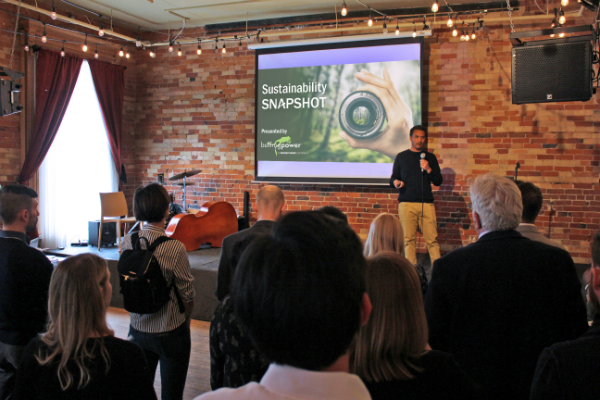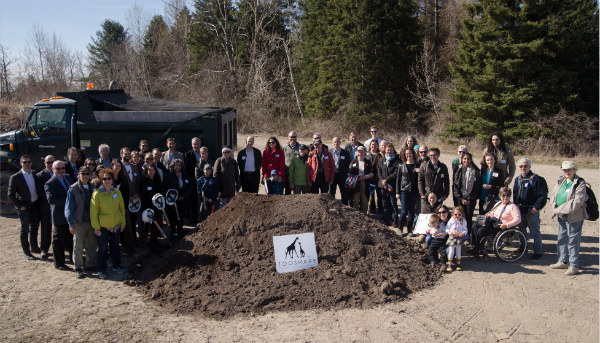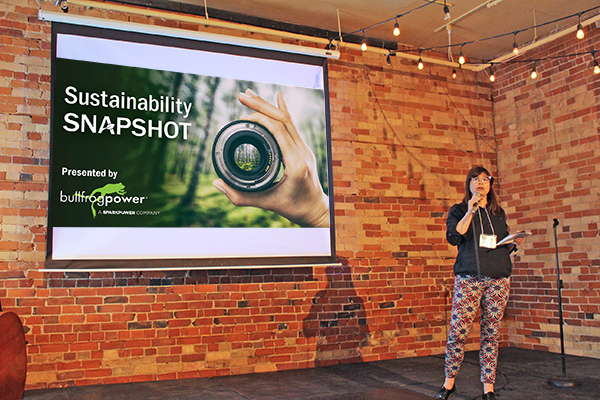[getsocial app=”sharing_bar” ]
Most members of the bullfrogpowered community have one thing in common: they’ll never be satisfied with the status quo. At our fourth annual Sustainability Snapshot, we invited three environmental innovators to talk about how they’re shaking up their respective industries.
Speakers from ZooShare, Dresden Vision, and the Gladstone Hotel shared how they’re putting sustainability at the heart of their operations—and how a planet-friendly mindset can boost every aspect of their business. Here are some of our favourite takeaways from the evening.
A clearer view of glasses production with Dresden Vision

About five years ago, a friend of Mike Murray asked him why glasses were so expensive and fragile. He had no idea, but he decided to find out. His discoveries led him to become the director of Dresden Vision Canada, a company devoted to producing sustainable, affordable glasses.
The sky-high price of your specs isn’t for lack of market size. There are 2.5 billion people who need glasses but who can’t afford them. That’s about a third of the global population.
Mike found out that there are just a couple of companies that dominate the vision market. Whether you’re buying designer frames or just lenses, you’re probably dealing with the same, massive company.
These optical giants are using their profits to make glasses even more of a premium product. The average margins in the industry are a whopping 1000% to 2000%, and they’re still getting bigger.
Getting back to basics
Mike and his team wanted to make glasses cheaper and better, so they decided to talk to some industry experts. He asked why there couldn’t be just one frame for everyone, and he was told that people have different-sized heads. “What if we just made different sizes?” he wondered.
As it turns out, simple ideas can be revolutionary ones. The team found a frame style that looked good on everyone and decided to create a modular, customizable pair of glasses.
Because each piece is interchangeable, the front of the frames and the arms can be different sizes to suit different head shapes. People can also play around with the colour of each piece.
“The net result is that the guy who makes our glasses… he lives in Sydney, Australia and he makes a pretty good wage, way above the cost of living. But our cost per unit is actually lower than manufacturing glasses in China,” Mike said.
Making sustainable specs
Dresden Vision is proud to pass its savings onto its customers. But cost isn’t the only concern—a key part of bettering a product is making it more sustainable.
Most glasses aren’t recyclable and will eventually end up in landfill. Glasses from Dresden can go right in the blue bin (although Mike doesn’t recommend this, seeing as many blue bin contents will never be recycled). Instead, customers can bring their glasses back to Dresden, where they’ll be melted down and turned into a new pair.
Dresden glasses also weigh about half as much as a traditional pair of glasses. “It’s basically like sweatpants on your face,” Mike quipped. All jokes aside, using half the materials is a big win on the sustainability front.
Mike ended his talk on a revolutionary note: “We have customers who are billionaires, and we have customers who are homeless. And for us, that’s really where we want to go. Our end game is the democratization of eyewear.”
From poo to power with ZooShare’s biogas plant

Have you ever thought about what happens to all the poo from the Toronto Zoo? Daniel Bida sure has. As the Executive Director of ZooShare Biogas Co-operative, Daniel sees animal excrement and food waste in a new light—as a valuable resource.
ZooShare plans to feed manure and local food waste into an anaerobic digestor. Daniel describes the digestor as a big concrete stomach because it functions similarly to a human stomach.
As the waste breaks down, it will produce biogas that can be cleaned up and used in the same ways as natural gas. ZooShare plans to burn it to produce 500 KWs of electricity, but it could also be used in a natural gas vehicle or injected onto the pipeline as Renewable Natural Gas, which ZooShare may do in the future.
While the zoo poo might be the most eye-catching part of ZooShare’s business model, Daniel was quick to point out that food waste will produce much more energy than manure. After all, food waste hasn’t already been digested.
What comes around, goes around
The biogas process creates nutrient-rich fertilizer as a byproduct. To Daniel, this is a great example of the circular economy in action. When food waste goes to landfill, its nutrients are lost forever. But when it goes to a biogas plant, those nutrients make their way back into the food system when the fertilizer is spread on farm fields or backyard gardens.
ZooShare’s plant will be digesting 15 thousand tonnes of food waste per year in its first phase. It’ll double that in phase 2. And for every tonne of waste that it diverts from landfill, it’ll reduce greenhouse gas emissions by 1.39 tonnes.
Sharing the knowledge
Daniel also spoke about ZooShare’s education program. So far, the team has taught more than five thousand schoolchildren about biogas. “I’m proud to say that the lesson has sunk in,” he said. “They are very excited about poo! When we go to events, we bring a jar full of giraffe poo and the kids love it.”
Going forward, ZooShare will help students build a mini biodigestor to process their lunchtime waste. After about a month, they’ll produce some biogas and fertilizer. They’ll then be able to see how their fertilizer helps bean plants grow.
Daniel has also raised awareness about food waste among adults. “I get a lot of very lame poo jokes,” he lamented. “But for me, the real win is the lightbulb that goes on in people’s minds when they understand that the banana peel that they just threw in the garbage – or any other organic waste they can think of – is actually a very valuable resource.”
The art of conversation with the Gladstone Hotel

Christina Zeidler, the President of the Gladstone Hotel, used her talk as an opportunity to share how art, sustainability, and business coexist at the Gladstone.
“What is revolutionary about the Gladstone, and why I believe that we’re a leader, is that we’ve used art as a methodology for business,” she declared. “And we think about that big umbrella of art as being so connected to things like sustainability that sometimes I forget to even separate them out.”
Christina spoke of Grow Op, an annual Gladstone exhibition that explores landscape architecture, urbanism, and ecology through the lens of contemporary art. She sees Grow Op as an opportunity for hotel guests and Torontonians to come talk to artists and cultivate ideas.
The infamous chicken coop
The Gladstone has green roofs that are occasionally used as art spaces. During a previous Grow Op event, artists installed a chicken coop on the roof—at the time, chicken farming was illegal in Toronto.
Christina explained that the goal was to start a conversation about the productive use of small urban landscapes. The Gladstone also wanted to leverage one of its green initiatives to lead to a larger discussion about sustainability. These types of conversations are another way that they weave together art, sustainability, and business.
From discarded threads to dialogue
A piece from the 2017 edition of Grow Op, “WASTED” by the Crazy Dames, gave visitors the opportunity to interact with a room full of art. “People could come in and start to make very simple braids out of ripped material,” Christina said.
All of the material was discarded fabric from the City of Toronto. Around the room, there were staggering statistics about how much textile waste ends up in landfill.
As people came and started to fill the room with braids, they were invited to talk about how Toronto is lacking a recycling program for textiles.
“What’s so important about Grow Op is that in many of the exhibitions we do, the artists are present,” Christina said. “You can talk to the artists; it isn’t an abstract thing, something that you don’t have an access point to… Contemporary art should not be an opaque material. There should be transparency and conversation.”
“Art is not a frivolous activity,” Christina said in her closing remarks. “It is core to our methodology, and it has been a teacher in the way that we do things. And at its core is the value of sustainability.”
In conclusion…
This year’s Sustainability Snapshot speakers came from three very different industries, but their philosophies were surprisingly similar. Many themes reappeared throughout the evening, providing us with important food for thought.
From Dresden’s improved glasses and the Gladstone’s illicit chicken coop, we learned that problems become easier to solve once we kickstart the conversation.
From ZooShare’s biogas plant and Grow Op’s WASTED art installation, we were reminded that one person’s trash is another person’s resource.
Perhaps most importantly, all three speakers affirmed that good environmental practices and good business can go hand in hand. As more customers choose to support companies with strong sustainability commitments, going green is no longer a pipe dream—it’s a necessity in today’s competitive market.